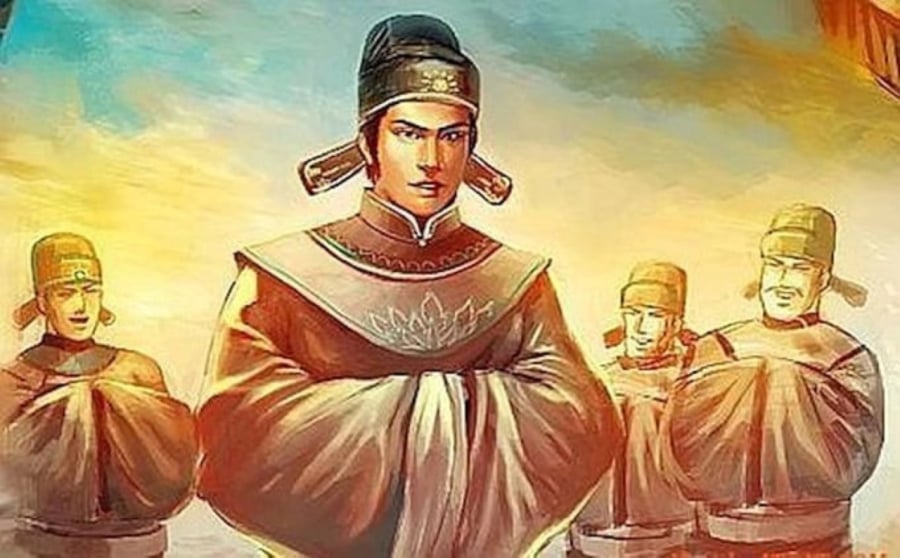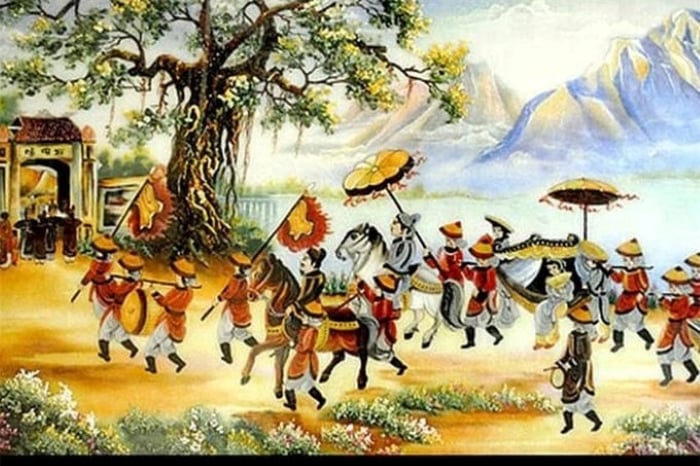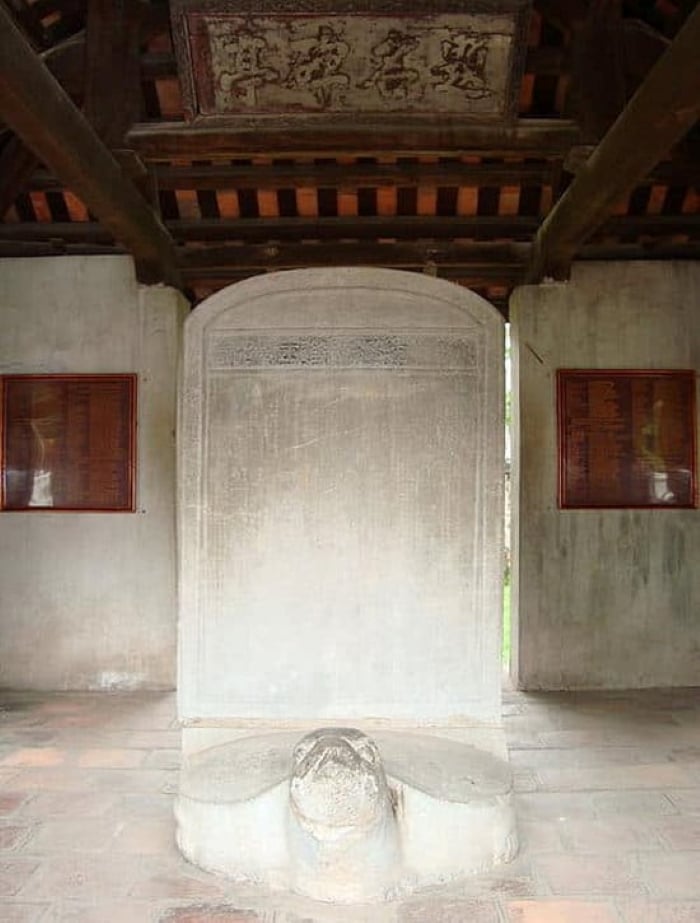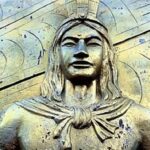Nguyen Truc was the first confirmed Luong Quoc Trang Nguyen (Trạng nguyên of Two Countries). He was the first Trạng nguyên of the Later Lê Dynasty and the first to have his name engraved on the Doctor’s stele at the Temple of Literature in Hanoi.
A talented scholar who continued his studies while herding buffalo
Nguyen Truc (1417-1474), the Luong Quoc Trang Nguyen, was born in Boi Khe village, Tam Hung commune, Quoc Oai district, present-day Hanoi. He came from a family of scholars and officials; his great-grandfather, grandfather, and father were all doctors and served in the royal court.
From a young age, Nguyen Truc was known for his intelligence and diligence in studying. Despite his family’s position in the royal court, they lived a simple and honest life. Nguyen Truc often had to herd buffalo while studying, hanging his books on the buffalo’s horns. By the age of 12, he excelled in literature and poetry.
In the first year of the Thieu Binh era, during the reign of King Le Thai Tong (1434), the 17-year-old Nguyen Truc passed the Huong exam, becoming a Giai Nguyen. In the third year of the Dai Bao era (1442), he took the court exam and achieved the highest rank of Doctor (Tien Si) at the young age of 25.
Nguyen Truc was bestowed with the title “Quoc Tu Giam Thi Thu” by the king and awarded A Liet Khanh, ranking first among the 33 doctors of the same course. This examination in Sino-Vietnamese literature in 1442 was the first to be inscribed on the stele, and the exam was chaired by Nguyen Trai.

For the first time in the history of Vietnam, the King bestowed the Trạng Nguyên hat and robe on someone from his village. (Illustration)
After becoming a Trạng nguyên, in May 1442, Nguyen Truc’s father passed away, and he had to return to his hometown to mourn. In 1444, during the reign of King Le Nhan Tong, Nguyen Truc was appointed Chieu Nghi Dai Phu Han Lam Vien Hoc Si Vu Ky Uy.
Soon after, he was summoned to the court and granted the title of Chieu Nghi Dai Phu Han Lam Vien Hoc Si. In 1445, his official title changed to Thieu Trung Khanh Dai Phu, Ngu Su Dai Ngu Su Thi Do Uy. However, Nguyen Truc declined the position, and it took three royal edicts before he finally accepted.
The First Luong Quoc Trang Nguyen in Vietnamese History
Nguyen Truc was once sent by the king as a chief envoy to the Ming Dynasty. During this trip, he and his deputy, Trinh Thiet Truong, requested to take the Ming court exam to showcase the talent of Vietnamese scholars. Their request was granted by the Ming Emperor.
They followed the same rules as other candidates during the exam. After the exam papers were marked and the names matched, Nguyen Truc was announced as the Trạng nguyên, and Trinh Thiet Truong as the Bang Nhan. The Ming Emperor praised them, saying, “Every land has its talents,” and bestowed upon Nguyen Truc the title of Luong Quoc Trang Nguyen. Upon their return, both were promoted to the position of Thuong Thu and awarded eight golden words: “Thanh cong danh Nam Bac trieu bien nga” (Success and fame in both Southern and Northern dynasties are mine).

Nguyen Truc was the first Vietnamese to become a Trạng Nguyên in two countries. (Illustration)
In 1454, the year of the Giap Tuat, Nguyen Truc’s mother passed away, and he resigned from his position to mourn his mother in his hometown. During this time, he devoted himself to studying, teaching, and practicing medicine, gaining a reputation as a skilled physician. Many prominent scholars and doctors were his students during this period.
As a virtuous and honest official, Trạng nguyên Nguyen Truc was beloved by King Le Nhan Tong. During the time Nguyen Truc was mourning his mother, the king had a portrait of him placed next to the throne, showing his fondness for the Trạng nguyên. This was a rare case in the feudal history of a Trạng nguyên being so highly regarded by the king.
When King Le Nhan Tong was assassinated, Nguyen Truc composed a funeral oration, expressing his grief and recounting the late king’s virtues. In 1460, when Le Thanh Tong ascended the throne, Nguyen Truc was held in even higher esteem. The king sent the book Thien Nam Du Ha Tap to Nguyen Truc’s house for him to read and critique.
In the same year, he was appointed Tuyen Phung Dai Phu, Trung Thu Lenh, a high-ranking position among the civil officials. Notably, on several occasions, Nguyen Truc requested to return to his hometown, but the king refused each time.
A Place That Promotes the Tradition of Learning
Nguyen Truc passed away in 1474 at the age of 57. After his death, he was buried in Bach Thach village (in present-day Hoa Thach commune, Quoc Oai district). A temple was also built in his honor in Song Khe village, his father’s hometown, in Tam Hung commune.
The temple dedicated to Nguyen Truc, the Luong Quoc Trang Nguyen, features a double-layered roof with two ridges, and the roof corners are adorned with dragons riding the clouds, each holding a luminous pearl in its mouth. The temple’s gate bears the inscription: “Luong Quoc Trang Nguyen Tu.” In front of the yard stands a stone stele from the Nguyen Dynasty, inscribed with the words “Boi Khe Nguyen Toc Bia Ky.”
The temple consists of three compartments; the two side compartments house two ancient stone steles that recount Nguyen Truc’s life and accomplishments. The central compartment houses the altar and a certificate recognizing the site as a National Historical and Cultural Relic (in 2011). The temple also features large calligraphy pieces: “Quoc An Gia Khanh,” “Chung Dinh Du Gia,” and “Nguyen Thi Tu Duong.” The two sides of the temple feature unique carved and openwork dragon patterns.

Doctor’s stele of Trạng Nguyên Nguyen Truc at the Temple of Literature, from the 1442 exam.
In his hometown of Thanh Oai, a school bears the name of the Luong Quoc Trang Nguyen: Nguyen Truc Secondary School in Kim Bai town, honoring this eminent scholar and serving as a reminder to future generations of his exemplary life.






































